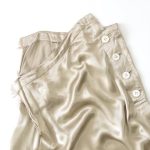Are you looking to give your denim fabric a trendy, frayed look? Look no further! In this article, we’ll guide you through the step-by-step process of fraying denim fabric.
You’ll learn how to select the right fabric, prepare your tools, mark the areas to be frayed, and create frayed edges using scissors.
We’ll also show you how to distress the fabric with sandpaper and add extra fraying with a seam ripper.
Finally, we’ll explain how to wash and dry the fabric for a more natural fray.
Let’s get started!
Table of Contents
Select the Right Denim Fabric
To select the right denim fabric, you’ll want to consider the weight, color, and stretchiness.
When it comes to denim colors, there are numerous options available. Classic indigo is a popular choice, but you can also find denim in black, white, gray, and various shades of blue. Consider your personal style and the overall look you want to achieve when selecting a color.
Different denim weights can greatly affect the final outcome of your project. Lightweight denim is ideal for summer garments and projects that require draping, while heavier weights are better suited for winter wear and more structured designs. Keep in mind that heavier denim may take longer to fray and distress.
Stretchiness is another factor to consider. If you prefer a more fitted look or plan to create garments that require movement, opt for denim with some stretch. This will allow for added comfort and flexibility. However, if you’re aiming for a more traditional or vintage look, non-stretch denim is the way to go.
Prepare Your Tools and Materials
Gather all of the necessary tools and materials before starting. Here are the items you will need:
-
Denim fabric: Choosing the right denim fabric for fraying is crucial. Look for a fabric that is sturdy and has a tight weave. Avoid fabrics that are too thin or stretchy, as they may not fray well.
-
Scissors: A good pair of fabric scissors is essential for achieving precise frayed edges. Make sure they are sharp and have a comfortable grip.
-
Chalk or fabric marker: Use chalk or a fabric marker to mark the areas where you want to create the frayed edges. This will help you achieve a more precise and controlled look.
-
Seam ripper: A seam ripper is handy for removing any unwanted stitching or seams before fraying the fabric. It allows you to easily separate the threads and create clean frayed edges.
-
Sandpaper or a pumice stone: To enhance the frayed look, you can use sandpaper or a pumice stone to rub against the edges of the fabric. This will distress the fibers and create a more worn-in appearance.
Mark the Areas to Be Frayed
When it comes to fraying techniques for denim, knowing the right tools for marking denim is essential.
Precision plays a crucial role in achieving the desired frayed look.
In this discussion, we will explore the different fraying techniques, the tools you need for marking denim, and why precision is important in creating the perfect frayed design.
Fraying Techniques for Denim
You can easily achieve a frayed look on denim fabric by using sandpaper or a cheese grater. These fraying techniques are commonly used for denim distressing.
To start, place the denim fabric on a flat surface and choose the areas you want to fray. Hold the sandpaper or cheese grater firmly and rub it back and forth over the selected areas. The rough surface of the sandpaper or the sharp edges of the cheese grater will gradually wear down the threads, creating a frayed effect.
Keep rubbing until you achieve the desired level of fraying. Remember to work slowly and be careful not to damage the fabric too much.
These simple techniques can give your denim fabric a trendy and worn-in look.
Tools for Marking Denim
There are various tools available for marking denim, such as chalk, fabric markers, and tailor’s chalk. When it comes to distressing denim, having the right tools can make all the difference. Here are some alternative marking methods to help you achieve that perfectly frayed look:
-
Chalk: Chalk is a popular choice for marking denim because it easily rubs off and doesn’t leave any permanent marks. It’s great for making temporary guidelines for distressing.
-
Fabric Markers: Fabric markers are another option for marking denim. They come in a variety of colors and can be used to draw patterns or designs on your fabric before distressing.
-
Tailor’s Chalk: Tailor’s chalk is a versatile tool that can be used on many types of fabric, including denim. It’s ideal for making precise markings and is easily visible on darker denim.
Whether you choose chalk, fabric markers, or tailor’s chalk, having the right tools will help you achieve the desired distressed effect on your denim fabric.
Importance of Precision
Having the right tools is essential for achieving a precise distressed effect on your denim. When it comes to fraying denim, accuracy is key to achieving the desired frayed look. The importance of accuracy lies in creating intentional and controlled distressing, rather than haphazardly damaging the fabric.
By using the right tools, such as sharp scissors or a seam ripper, you can accurately cut and remove threads to create a frayed effect that looks intentional and stylish. Precision is necessary to ensure that the frayed areas are even and balanced, giving your denim a professional and well-crafted appearance.
Without the proper tools and attention to detail, you risk creating a messy and uneven distressed effect on your denim, diminishing its overall aesthetic appeal. So, take the time to invest in the right tools and practice precision to achieve that perfect frayed look.
Use Scissors to Create Frayed Edges
If you’re looking to create frayed edges on your denim, one of the key decisions you’ll have to make is whether to use scissors or other tools. Both options have their pros and cons, so it’s important to weigh them carefully before making your choice.
Additionally, the type of denim you use can greatly impact the final result, so it’s worth considering which type of denim is best for fraying.
Scissors or Other Tools?
When fraying denim fabric, you can use scissors or other tools. Scissors are a popular choice for creating frayed edges on denim because they offer precise control over the fraying process. However, there are other tools you can use to achieve different fraying effects. One alternative to scissors is sandpaper, which can be used to gently rub the edges of the fabric, creating a softer and more natural-looking fray. Another tool you can try is a seam ripper, which allows you to remove individual threads to create a more distressed and uneven edge. It’s important to consider the desired outcome and the level of control you want when choosing between scissors and other tools for fraying denim fabric.
| Scissors | Sandpaper | Seam Ripper |
|---|---|---|
| Offers precise control | Creates a softer fray | Allows for individual thread removal |
| Can be used for small or intricate designs | Requires more time and effort | Creates a distressed and uneven edge |
| Easy to find and use | May require practice to achieve desired results | Provides a unique fraying effect |
| Suitable for beginners | Can be used on various fabrics | Versatile tool for fraying and distressing |
Best Denim for Fraying?
The best type of denim to use for fraying is one that is sturdy and has a tight weave. Here are some key factors to consider when choosing the best denim for fraying:
- Quality: Look for well-known denim brands that are known for their high-quality materials and craftsmanship.
- Weight: Opt for a medium to heavyweight denim fabric, as it will hold up better during the fraying process.
- Weave: Choose denim with a tight weave to ensure that the frayed edges will be clean and neat.
- Stretch: While stretch denim can be frayed, it may not give you the same structured look as non-stretch denim.
- Color: Consider the desired outcome of your frayed denim. Darker denim tends to create a more dramatic effect, while lighter denim gives a more casual look.
Experiment with different fraying techniques to achieve your desired style, such as using sandpaper, a cheese grater, or even a box cutter. Remember to always test on a scrap piece of fabric first to ensure the desired effect before working on your actual garment.
How to Prevent Fraying?
To prevent fraying, you can try applying a small amount of fabric glue to the edges. This will create a barrier that stops the fabric from unraveling.
Another alternative to scissors is using a hot knife. This tool cuts and seals the edges of the fabric at the same time, preventing fraying.
If you don’t have access to a hot knife, you can also use a lighter. Carefully run the flame along the edges of the fabric, making sure not to burn it. The heat will melt the fibers together, preventing fraying. Just be cautious when using fire and always have a fire extinguisher nearby.
These alternatives can be handy when you don’t have scissors on hand or want a different method to prevent fraying.
Distress the Fabric With Sandpaper
Use sandpaper to distress the fabric and create a worn-out look. It’s a simple and effective technique that can give your denim a trendy, vintage appearance. But what if you don’t have sandpaper on hand or want to explore other creative fraying techniques? Don’t worry, there are alternatives to sandpaper that you can use to achieve similar results.
Here are some sandpaper alternatives and creative fraying techniques to try:
-
Pumice stone: Rub a pumice stone against the fabric to create a frayed effect. This natural stone is gentle on the material and can be used to distress denim without causing damage.
-
Cheese grater: Take a cheese grater and gently rub it against the fabric to achieve a frayed look. This technique works best on thicker denim and allows you to control the intensity of the fraying.
-
Razor blade: Use a razor blade to carefully cut and distress specific areas of the fabric. This technique is great for adding intentional distressing to your denim, such as creating small holes or frayed edges.
Remember to always test these techniques on a small, inconspicuous area of the fabric before applying them to the entire garment. Have fun experimenting with different techniques to create your desired frayed denim look!
Add Extra Fraying With a Seam Ripper
If you’re looking to achieve a more distressed look, try using a seam ripper to add extra fraying to your garment. A seam ripper is a handy tool that can help you achieve a worn and frayed effect on your denim fabric.
However, if you don’t have a seam ripper on hand, there are alternative methods you can try to achieve the same result. One alternative is using a pair of small, sharp scissors to carefully cut and fray the edges of your fabric. Another option is using a pumice stone or sandpaper to rub and distress the fabric, creating a frayed appearance. Additionally, you can also experiment with different fraying methods such as using a wire brush or a cheese grater to roughen up the fabric.
Remember to be patient and take your time when distressing your garment, as it’s easy to go overboard and create unintended holes or tears. With a little practice and experimentation, you can achieve the perfect frayed look for your denim fabric.
Wash and Dry for a More Natural Fray
Now that you’ve learned how to add extra fraying with a seam ripper, let’s move on to another technique that will give your denim fabric a more natural fray. By washing and drying your denim, you can achieve a worn-in look that mimics the natural wear and tear of time.
To achieve a natural fray, follow these steps:
-
Select the right denim fabric: Choose a fabric with a looser weave, such as a medium-weight or lightweight denim. This will allow the fabric to fray more easily during the washing process.
-
Pre-wash your denim: Before you start the fray process, it’s important to pre-wash your denim to remove any sizing or chemicals that may interfere with the fraying process.
-
Place your denim in a mesh laundry bag: To protect your denim and prevent it from tangling or getting damaged in the washing machine, place it in a mesh laundry bag.
-
Wash on a gentle cycle: Set your washing machine to a gentle cycle with cold water. This will help preserve the color and integrity of your denim while still allowing it to fray.
-
Air dry or tumble dry on low: After washing, either air dry your denim or tumble dry it on a low heat setting. Avoid high heat as it can shrink or damage your fabric.
Conclusion
So there you have it – a simple and effective way to fray your denim fabric.
By following these steps and using the right tools, you can achieve the perfect frayed look for your jeans or other denim projects.
Remember to be careful and take your time with each step, ensuring that you achieve the desired amount of fraying.
Once you’re done, wash and dry your fabric to enhance the natural fray.
Now go ahead and give it a try – you’ll be rocking that trendy frayed denim in no time!
- The History and Evolution of Chamois Fabric - June 22, 2025
- Chamois Fabric on Wikipedia: What You Need to Know - June 22, 2025
- How to Pronounce Chamois Fabric Correctly - June 22, 2025





